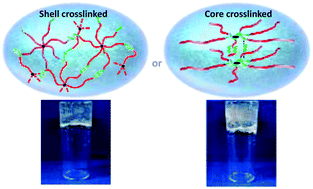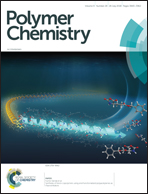Disulphide crosslinked star block copolypeptide hydrogels: influence of block sequence order on hydrogel properties†
Abstract
Reported are a series of 32- and 64-arm star shaped diblock copolypeptides containing opposite block sequences of oligo(cysteine) and poly(lysine) resulting in hydrogels comprising core and shell mediated disulfide crosslinking. Spontaneous gelation was observed within minutes of aqueous immersion, without any necessary pretreatment at concentrations as low as 0.05 wt%. The secondary structure underwent a change in agreement with the gel–sol transition as evidenced by a combination of FT-IR and CD spectroscopy. Changing the sequence on the 32-arm from core crosslinking to shell crosslinking had a significant effect on the hydrogel storage modulus as it changed from 820 Pa to 4530 Pa. Notably, changing the polypeptide block sequence order had a direct effect on mechanical properties (including self-recovery behaviour). While the core crosslinked hydrogel underwent shear induced recovery almost instantaneously after passing through a standard syringe needle, the shell crosslinked hydrogel expelled water when subject to the same shear. The responsiveness of the molecular system to redox stimuli provides further desirable attributes that could allow for controlled, targeted delivery of therapeutic payloads.



 Please wait while we load your content...
Please wait while we load your content...
